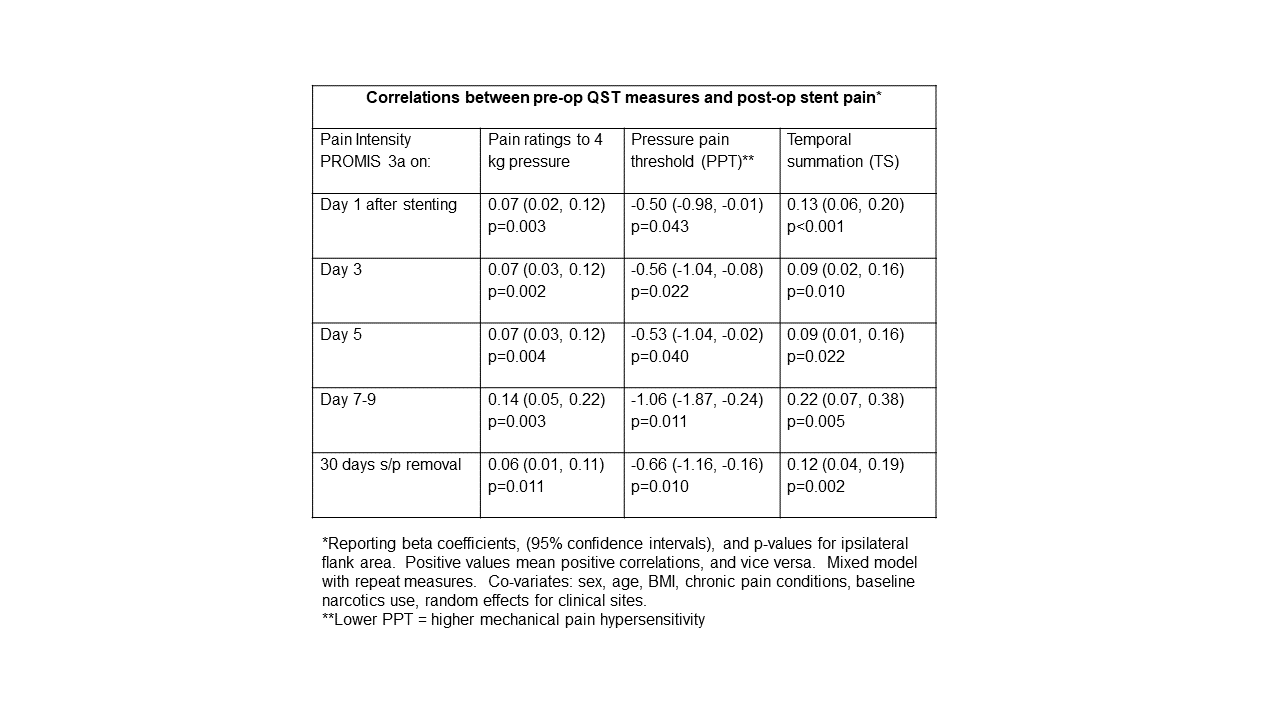Back
Introduction: To examine the relationship between pre-operative central sensitization and hypersensitivity to pain, and post-operative stent pain after ureteroscopy (URS) for stones.
Methods: Adult participants enrolled in the USDRN STudy to Enhance uNderstanding of sTent-associated Symptoms (STENTS) underwent quantitative sensory testing (QST) prior to URS and stent placement. Hypersensitivity to mechanical pain was assessed with pressure algometer. Participants rated their pain intensity (0-100) to 2 kg and 4 kg pressure applied to the flank and lower abdominal quadrant on the side of planned stent, and the contralateral forearm (control). Pressure pain thresholds (PPT) were also assessed. Central sensitization was assessed by applying a pinprick stimulator and calculating temporal summation (TS). Post-operative stent pain was assessed using PROMIS questionnaires for pain intensity and pain interference. Data were analyzed using repeated-measures mixed-effects models.
Results: Among the 412 participants with QST data, median age was 54 years, 46% were female. Higher pre-operative pain ratings to mechanical pressure to the ipsilateral flank and abdominal areas were associated with higher stent pain intensity on post-operative days 1, 3, 5, 7-9, and 30 days post-stent removal (p < 0.05). Lower pre-operative PPT (i.e. higher mechanical hypersensitivity) was associated with higher post-operative pain intensity (p < 0.05). Greater degree of central sensitization pre-operatively (higher TS) was associated with higher post-operative pain intensity (p < 0.05). Significant correlations existed between pre-operative QST measures at the ipsilateral flank area and post-operative stent pain intensity (Table). Similar correlations were observed for ipsilateral abdominal area but not consistently for the forearm control site (data not shown).
Conclusions: We have identified a physiological risk factor associated with stent pain. Preoperative central sensitization and hypersensitivity to pain were associated with post-operative stent pain. QST is a potential tool to identify patients likely to experience post-URS stent pain, which may facilitate early identification for mitigation, counseling, and management options. SOURCE OF
Funding: NIH/NIDDK

Podium Session
Session: PD34: Stone Disease: Epidemiology & Evaluation II
PD34-03: Pre-operative Central Sensitization and Hypersensitivity to Pain is Associated with Ureteral Stent Pain: Findings from the Urinary Stone Disease Research Network (USDRN)
Sunday, April 30, 2023
1:20 PM – 1:30 PM CST
Location: S502

Henry Henry Lai, MD
Professor of Urology and Anesthesiology
Washington University School of Medicine
Podium Presenter(s)
Introduction: To examine the relationship between pre-operative central sensitization and hypersensitivity to pain, and post-operative stent pain after ureteroscopy (URS) for stones.
Methods: Adult participants enrolled in the USDRN STudy to Enhance uNderstanding of sTent-associated Symptoms (STENTS) underwent quantitative sensory testing (QST) prior to URS and stent placement. Hypersensitivity to mechanical pain was assessed with pressure algometer. Participants rated their pain intensity (0-100) to 2 kg and 4 kg pressure applied to the flank and lower abdominal quadrant on the side of planned stent, and the contralateral forearm (control). Pressure pain thresholds (PPT) were also assessed. Central sensitization was assessed by applying a pinprick stimulator and calculating temporal summation (TS). Post-operative stent pain was assessed using PROMIS questionnaires for pain intensity and pain interference. Data were analyzed using repeated-measures mixed-effects models.
Results: Among the 412 participants with QST data, median age was 54 years, 46% were female. Higher pre-operative pain ratings to mechanical pressure to the ipsilateral flank and abdominal areas were associated with higher stent pain intensity on post-operative days 1, 3, 5, 7-9, and 30 days post-stent removal (p < 0.05). Lower pre-operative PPT (i.e. higher mechanical hypersensitivity) was associated with higher post-operative pain intensity (p < 0.05). Greater degree of central sensitization pre-operatively (higher TS) was associated with higher post-operative pain intensity (p < 0.05). Significant correlations existed between pre-operative QST measures at the ipsilateral flank area and post-operative stent pain intensity (Table). Similar correlations were observed for ipsilateral abdominal area but not consistently for the forearm control site (data not shown).
Conclusions: We have identified a physiological risk factor associated with stent pain. Preoperative central sensitization and hypersensitivity to pain were associated with post-operative stent pain. QST is a potential tool to identify patients likely to experience post-URS stent pain, which may facilitate early identification for mitigation, counseling, and management options. SOURCE OF
Funding: NIH/NIDDK

